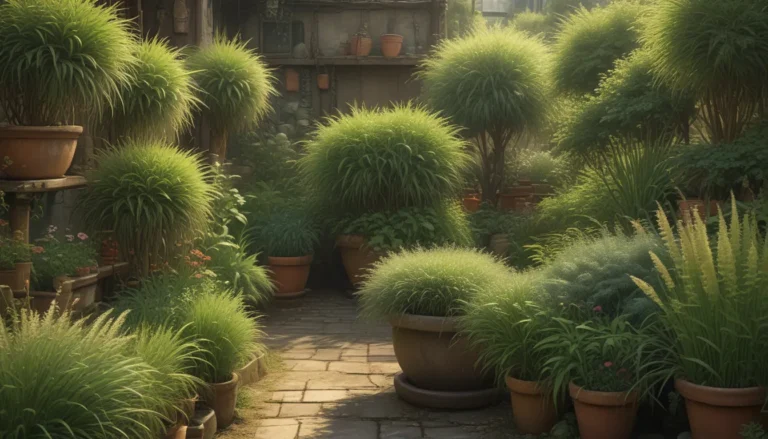How to Grow and Care for Pagoda Dogwood Trees

Are you ready to add some architectural elegance to your garden? Look no further than the pagoda dogwood tree, Cornus alternifolia. This stunning tree boasts lush foliage, beautiful blooms, and unique tiered branching that will add a touch of sophistication to any landscape.
If you’re new to growing pagoda dogwood trees, fear not! In this comprehensive guide, we’ll cover everything you need to know to successfully cultivate and care for these eye-catching trees. From propagation and cultivation to pruning and maintenance, we’ve got you covered. So let’s dive in and unlock the secrets of growing and caring for pagoda dogwood trees!
What Are Pagoda Dogwoods?
The pagoda dogwood, also known as Cornus alternifolia, is a small deciduous tree that belongs to the Cornaceae family. Native to the eastern half of North America, this tree can be found growing in forests, along stream banks, and in fields across a wide geographic range.
One of the most striking features of the pagoda dogwood is its tiered, horizontally branching structure, which gives it a unique layered look reminiscent of a pagoda. The tree typically grows to 15 to 25 feet tall and 20 to 32 feet wide at maturity, making it an ideal choice for smaller gardens or as a focal point in larger landscapes.
In addition to its distinctive branching pattern, the pagoda dogwood produces oval-shaped green leaves that turn a reddish-purple color in the fall. Small, fragrant yellow blooms appear in late spring, followed by blue-black drupes that provide food for birds and other wildlife.
Cultivation and History
The pagoda dogwood has a rich history and a variety of uses beyond its ornamental value. It is part of the larger Cornus genus, which includes 58 species of trees, shrubs, and rhizomatous herbs found across multiple continents.
In addition to its aesthetic appeal, the pagoda dogwood produces dense, fine-grained lumber that has been used to make a variety of items, from tool handles to golf club heads. The tree also provides habitat and food for birds and mammals, making it a valuable addition to any ecosystem.
In traditional Chinese medicine, the pagoda dogwood has been used for its analgesic, diuretic, and tonic properties. And in the landscape, its horizontally branching form makes it a popular choice for adding visual interest and structure to gardens.
Propagation of Pagoda Dogwoods
If you’re interested in propagating pagoda dogwood trees, there are several methods you can use to increase your plant collection. From seed propagation to cuttings and transplanting, there are options available for gardeners of all skill levels.
From Seed
To propagate pagoda dogwood from seed, collect ripe seeds from local specimens in late August to mid-September. Remove the pulp from the seeds and separate the viable seeds from non-viable ones by placing them in water.
Plant the seeds in fertile, well-draining soil outdoors, spacing them apart based on the mature size of the tree. Keep the soil moist as the seeds germinate and sprout, which can take several months or even up to two years in some cases.
From Cuttings
Alternatively, you can propagate pagoda dogwood from cuttings taken in summer. Use sterile blades to take cuttings from healthy shoots and root them in a mixture of peat moss and perlite.
Keep the cuttings moist and provide them with sunlight until roots form, then transplant them into individual containers. Harden off the rooted cuttings in the spring before planting them in the garden.
Via Transplanting
For younger plants, you can also propagate pagoda dogwoods through transplanting. When transplanting, be sure to dig holes that are slightly wider and deeper than the root systems of the plants.
Whether you’re propagating from seed, cuttings, or transplanting, be sure to provide the right conditions for the new plants to thrive, including well-draining soil and adequate moisture.
How to Grow Pagoda Dogwood Trees
To ensure your pagoda dogwood trees grow and thrive, there are a few key factors to consider, including climate, soil, and maintenance requirements.
Climate and Exposure Needs
Pagoda dogwoods are best suited to USDA Hardiness Zones 3 to 7 and prefer partial shade, though they can tolerate full sun in cooler climates. In warmer regions, planting them in wind-protected sites can help prevent damage.
For the best results, plant pagoda dogwoods in well-draining soil with a slightly acidic pH of 5.5 to 6.5. Keep the soil moist by watering whenever the top few inches feel dry to the touch.
Irrigation and Fertilization Needs
Pagoda dogwoods require moderate moisture levels to thrive, so be sure to water them regularly to keep the soil moist. Adding organic matter such as compost or well-rotted manure to the soil each spring can help provide essential nutrients.
To keep your pagoda dogwood trees healthy and vigorous, follow these growing tips:
- Partial shade is ideal, but full sun works as well.
- Provide well-draining soil with a pH of 5.5 to 6.5.
- Keep the soil moist by watering whenever the top one to two inches of soil feel dry.
Pruning and Maintenance
Proper pruning and maintenance are essential for keeping your pagoda dogwood trees healthy and looking their best. In early spring, prune the trees to accentuate their layered branching structure and remove any dead, damaged, or diseased branches.
Maintain a layer of mulch around the base of the tree to help retain moisture and suppress weeds. Rake up any fallen leaves in the autumn to prevent pest and disease issues and dispose of any branches damaged by ice in the spring.
For the best results, follow these tips for pruning and maintaining your pagoda dogwood trees:
- Prune in early spring to accentuate the tree’s layered aesthetic.
- Remove any diseased, damaged, or dead branches as needed.
- Maintain a layer of mulch around the base of the tree to retain moisture.
- Rake up fallen leaves in the autumn to prevent pest and disease issues.
Cultivars to Select
If you’re looking to add some variety to your pagoda dogwood collection, there are several cultivars to choose from that offer unique features and characteristics.
- Argenta: A shrubby version of the pagoda dogwood with white-variegated foliage.
- Bachone (Gold Bullion): A compact tree with golden foliage that turns shades of red and yellow in the fall.
- Black Stem: A tall tree with dark stems that provide visual interest in the winter.
- W. Stackman (Golden Shadows): A medium-sized tree with red foliage that transitions to yellow variegated leaves.
By selecting different cultivars, you can create a diverse and visually appealing garden that showcases the unique beauty of the pagoda dogwood tree.
Managing Pests and Disease
While pagoda dogwoods are relatively low-maintenance trees, they are susceptible to a few common pests and diseases that can impact their health and appearance.
Insects
Some of the most common insect pests that can affect pagoda dogwood trees include:
- Dogwood Borer: Larvae that feed on the inner bark and cambium of the tree, leading to decreased vigor and potential branch dieback.
- Leaf Miner: Larvae that feed on the foliage, leaving behind white tunnels and reducing photosynthesis.
- Scale: Round-bodied pests that suck the phloem from the tree, leading to reduced vigor and unsightly appearance.
To manage these pests, consider using insecticides or biological controls such as beneficial wasps to help control populations.
Disease
Pagoda dogwoods are also susceptible to several fungal diseases that can impact their health and appearance, including:
- Dogwood Anthracnose: A fungal disease that causes leaf spots, cankers, and branch dieback.
- Fungal Leaf Spot: Caused by various fungi, this disease results in small, dark leaf spots that can reduce photosynthesis.
- Golden Canker: A fungal disease that infects the bark, causing yellow-orange cankers that can lead to branch dieback.
To manage fungal diseases, prune infected branches, practice good sanitation, and consider applying fungicides to prevent further spread.
Best Uses for Pagoda Dogwood Trees
Pagoda dogwood trees are incredibly versatile and can be used in a variety of ways to enhance your landscape. Some of the best uses for these trees include:
- Specimen Planting: Plant a pagoda dogwood as a focal point in your garden to showcase its unique branching structure.
- Group Planting: Arrange multiple pagoda dogwood trees in groups to create an eye-catching display and add visual interest to your landscape.
- Border Planting: Use pagoda dogwoods as a border along the edge of your property to create a natural divider and add privacy to your garden.
- Woodland Gardens: Incorporate pagoda dogwoods into woodland gardens to create a naturalistic setting and attract a variety of wildlife.
No matter how you choose to use pagoda dogwood trees in your landscape, you’re sure to enjoy their beauty and charm for years to come.
Quick Reference Growing Guide
For a quick overview of the key points covered in this guide, refer to the following quick reference growing guide:
- Plant Type: Deciduous tree
- Hardiness (USDA Zones): 3-7
- Exposure: Full sun to partial shade
- Soil: Well-draining, pH 5.5-6.5
- Water Needs: Moderate
- Height: 15-25 feet
- Spread: 20-32 feet
- Uses: Grouping, shrub border, specimen, woodland garden
By following these guidelines and tips, you can ensure that your pagoda dogwood trees thrive and flourish in your garden.
Alternate Leaves for an Alternate Look
If you’re looking to add a touch of architectural elegance to your landscape, pagoda dogwood trees are an excellent choice. With their distinctive tiered branching and unique layered look, these trees are sure to make a statement in any garden.
So go ahead and give pagoda dogwood trees a try in your landscape. With the information and tips provided in this guide, you’ll be well-equipped to grow and care for these stunning trees. And remember, if you have any questions or need further assistance, feel free to leave a comment below!
Conclusion
In conclusion, pagoda dogwood trees are a wonderful addition to any garden, with their unique branching structure, attractive foliage, and beautiful blooms. By following the cultivation, propagation, and care tips outlined in this guide, you can successfully grow and maintain these trees in your landscape.
Whether you’re a seasoned gardener looking to add some architectural interest to your garden or a beginner looking to try something new, pagoda dogwood trees are a great choice. So why not give them a try and see for yourself the beauty and charm they can bring to your outdoor space?
If you have any questions or would like to share your experiences with growing pagoda dogwood trees, feel free to leave a comment below. Happy gardening!





